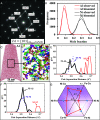Exceptional enhancement of mechanical properties in high-entropy alloys via thermodynamically guided local chemical ordering
- PMID: 37252982
- PMCID: PMC10265979
- DOI: 10.1073/pnas.2211787120
Exceptional enhancement of mechanical properties in high-entropy alloys via thermodynamically guided local chemical ordering
Abstract
Understanding the local chemical ordering propensity in random solid solutions, and tailoring its strength, can guide the design and discovery of complex, paradigm-shifting multicomponent alloys. First, we present a simple thermodynamic framework, based solely on binary enthalpies of mixing, to select optimal alloying elements to control the nature and extent of chemical ordering in high-entropy alloys (HEAs). Next, we couple high-resolution electron microscopy, atom probe tomography, hybrid Monte-Carlo, special quasirandom structures, and density functional theory calculations to demonstrate how controlled additions of Al and Ti and subsequent annealing drive chemical ordering in nearly random equiatomic face-centered cubic CoFeNi solid solution. We establish that short-range ordered domains, the precursors of long-range ordered precipitates, inform mechanical properties. Specifically, a progressively increasing local order boosts the tensile yield strengths of the parent CoFeNi alloy by a factor of four while also substantially improving ductility, which breaks the so-called strength-ductility paradox. Finally, we validate the generality of our approach by predicting and demonstrating that controlled additions of Al, which has large negative enthalpies of mixing with the constituent elements of another nearly random body-centered cubic refractory NbTaTi HEA, also introduces chemical ordering and enhances mechanical properties.
Keywords: chemical ordering; high-entropy alloys; thermodynamics.
Conflict of interest statement
The authors declare no competing interest.
Figures






References
-
- Laplanche G., et al. , Temperature dependencies of the elastic moduli and thermal expansion coefficient of an equiatomic, single-phase CoCrFeMnNi high-entropy alloy. J. Alloys Compd. 623, 348–353 (2015).
-
- Kozak R., Sologubenko A., Steurer W., Single-phase high-entropy alloys - An overview. Zeitschrift fur Krist. 230 (2015), 10.1515/zkri-2014-1739. - DOI
-
- Yeh J. W., et al. , Nanostructured high-entropy alloys with multiple principal elements: Novel alloy design concepts and outcomes. Adv. Eng. Mater. 6, 299–303 (2004).
-
- Ding Q., et al. , Tuning element distribution, structure and properties by composition in high-entropy alloys. Nature 574, 223–227 (2019). - PubMed
-
- de Vaucorbeil A., Sinclair C. W., Poole W. J., Atomistic insights into cluster strengthening in aluminum alloys. Materialia 4, 566–574 (2018), 10.1016/j.mtla.2018.11.020. - DOI
Grants and funding
- FA9550-17-1-0395/DOD | USAF | AMC | Air Force Office of Scientific Research (AFOSR)
- FA9550-20-1-0169/DOD | USAF | AMC | Air Force Office of Scientific Research (AFOSR)
- MOST110-2634-F-007-024/Ministry of Science and Technology, Taiwan (MOST)
- MOST110-2224-E-007-001/Ministry of Science and Technology, Taiwan (MOST)
- MOST110-2221-E-007-020-MY3/Ministry of Science and Technology, Taiwan (MOST)
LinkOut - more resources
Full Text Sources

